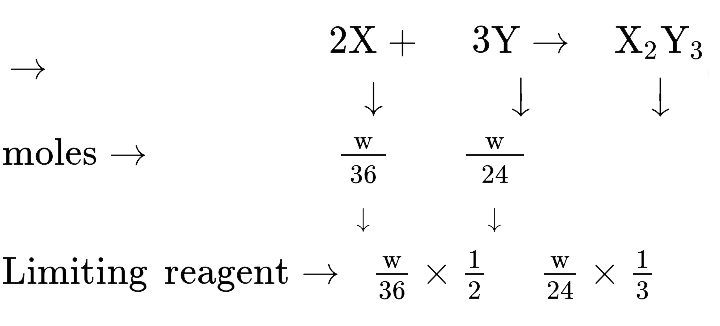Equal weight of 'X' (atomic weight=36) and 'Y' (atomic weight= 24) react to form the compound, . If that is the case, then
X is the limiting reagent
Y is the limiting reagent.
no reactant is left over and the mass of formed is double the mass of 'X' taken.
none of these apply
The correct Answer is:C
Let us assume that the weight of both reactant is w.

for
for
So no reactant is left over and the mass of will be 2w
Topper's Solved these Questions
Similar Questions
Equal weights of X (atomic weight = 36) and Y (atomic weight = 24) are reacted to form the compound X2Y3, which of the following is/are correct
View SolutionAn element A (atomic weight = 12) and B (atomic weight = 35.5) combines to form a compound X. If 4 mol of B combines with 1 mol of A to give 1 mol of X. The weight of 1 mol of X would be :
View Solution
Knowledge Check
Equal weights of X (atomic weight = 36) and Y (atomic weight = 24) are reacted to form the compound X2Y3, which of the following is/are correct
AX is the limiting reagentBY is the limiting reagen.CNO reactant is left over.DMass of X2Y3 formed is double the mass of X taken.Equal weight of X (atomic weight = 36) and Y(atomic weight = 24) are reacted to form compound X3Y5, which of the following is/are correct?
AX is the limiting reactantBY is the limiting reagentCNo reactant is left overDMass of X3Y5 formed is 1.9 times the mass of X takenEqual weights of X (At. Wt. = 36) and Y(At. Wt. = 24) are reacted to form the compound X2Y3. Then:
AX is the limiting reagentBY is the limiting reagentCno reactant is left over and mass of X2Y3 formed is double the mass of X taken:Dnone of the above
An element A (atomic weight = 12) and B (atomic weight = 35.5) combines ot form a compound X. If 5 mol of B comibnes with 1 mol of A to give 1 mol of X. The weight of 1 mol of X would be
View SolutionAn element A (atomic weight = 12) and B (atomic weight = 35.5) combines to form a compound X. If 4 mol of B combines with 1 mol of A to give 1 mol of X. The weight of 1 mol of X would be :
View SolutionAn element A (atomic weight = 12) and B (atomic weight = 35.5) combines ot form a compound X. If 5 mol of B comibnes with 1 mol of A to give 1 mol of X. The weight of 1 mol of X would be
View SolutionTwo elemets X( atomic weight =75) and Y( atomic weight =16) combine to give a compound having 75.8% X. The formula of the compound is
View SolutionTwo elemets X( atomic weight =75) and Y( atomic weight =16) combine to give a compound having 75.8% X. The formula of the compound is
View Solution
